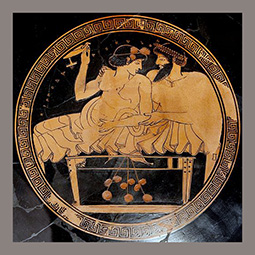Autore: P.G. Guzzo
Scarica l’articolo in formato .pdf: Ancora sulla stoà a U di Locri Epizefiri
 Si discute ancora della pertinenza della stoà a U al culto di Afrodite; e della sua destinazione diacronica ad hestiatorion. Si osserva come nei santuari nei quali è attestata la presenza di un hestiatorion questo è localizzato all’interno del relativo temenos. Durante i simposi era prevista la presenza di etere. In molti santuari (da Pyrgi a Erice) sono documentate “prostitute sacre”, delle quali è menzione anche a Locri Epizefiri. Si discute delle notizie al proposito contenute in Giustino e in Clearco da Soli. Si conclude dando per probabile l’attività di etere, non di ierodule, all’interno dello hestiatorion localizzato nella stoà a U di Locri Epizefiri.
Si discute ancora della pertinenza della stoà a U al culto di Afrodite; e della sua destinazione diacronica ad hestiatorion. Si osserva come nei santuari nei quali è attestata la presenza di un hestiatorion questo è localizzato all’interno del relativo temenos. Durante i simposi era prevista la presenza di etere. In molti santuari (da Pyrgi a Erice) sono documentate “prostitute sacre”, delle quali è menzione anche a Locri Epizefiri. Si discute delle notizie al proposito contenute in Giustino e in Clearco da Soli. Si conclude dando per probabile l’attività di etere, non di ierodule, all’interno dello hestiatorion localizzato nella stoà a U di Locri Epizefiri.
We discuss again the relevance of the U-shaped stoa to the cult of Aphrodite; and its diachronic destination as a hestiatorion. It can be observed that in sanctuaries where the presence of a hestiatorion is attested, this is located within the related temenos. During symposiums the presence of hetairai was expected. In many sanctuaries (from Pyrgi to Erice) “sacred prostitutes” are documented, they are mentioned also in Epizephyrian Locris. We discuss the information on this subject contained in Iustinus and in Klearchos. We conclude by assuming the activity of hetairai, not of hierodulai, within the hestiatorion located in the U-shaped stoa.

